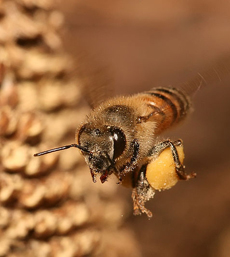NEWS: Honeybees On The Farm
|
We just received a beautiful email from Greg Quinn, a currant grower whose juice, Currant C, is a NIBBLE favorite and one of the highest antioxidant, anti-carcinogenic foods.
We love the description of the honeybees on the farm and would like to share it with all honey lovers: Well, we’re wrapping up spring in good stead here on the farm. I captured and hived a swarm of honey bees last week and this hive will be the start of a new bee yard over by the currant fields. It was a robust swarm of about 8,000 bees (3,500 bees weigh 22 lbs) and they’re doing great in their new home. Within 2 days they had made propolis* from the resin of tree sap and sealed up any small cracks and covered over all the knots in the new hive body. They are making honey and storing pollen and her majesty is laying about 500 eggs a day. In about a month, she’ll be up to 2,000 eggs each day!!! |
 How cute is this? A honeybee bringing a grain of pollen back to the hive. Photo by Muhammad Mahdi Karim | Wikimedia. |
|
|
If all goes well, the population of the hive should be in excess of 30,000 bees going into the winter. Worker bees, all females, live for 4-6 weeks during the working season; but the queen can live up to 6 years. The males, called drones, serve only one function [to breed new bees] and pretty much hang around most of the time eating the honey the females make, so they’re pretty expendable. Often they’ll be kicked out of the hive in the fall, to save the honey for the working members of the community. Honey is one of the most perfect foods on the planet, containing many of the amino acids which are the building blocks of life. Honey will never go bad and local raw (unpasteurized) honey is great to combat allergies because, homeopathically, it’s made from the same pollen that causes the allergies. Honey bees and farms share a very important relationship and I love my bees. *BEEHIVE TRIVIA: Propolis is a resinous mixture that honey bees collect from tree buds, sap flows or other botanical sources. They use it as a sealant for unwanted open spaces in the hive—small gaps of a quarter-inch or smaller. Larger spaces are usually filled with beeswax.
|
||


